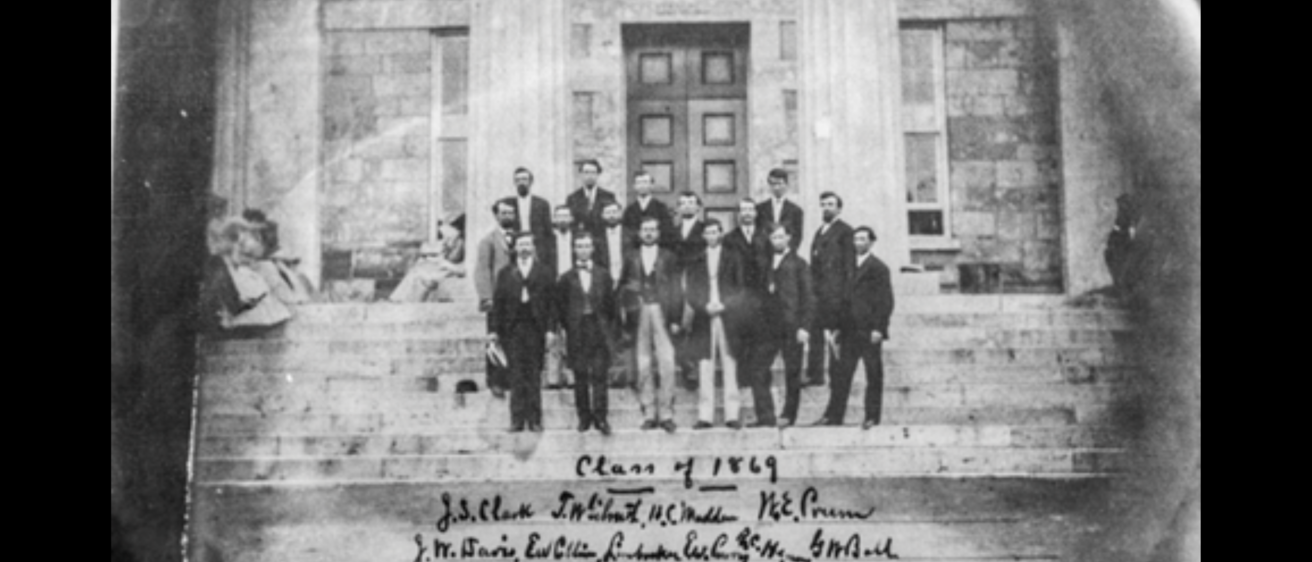FROM THE ARCHIVES: IOWA LAW COMMENCEMENT DINNER MENU CIRCA 1869

By: Molly Hill | May 13, 2020
Commencement is a joyous occasion for students. It marks the completion of a degree attained through hard work and dedication. To celebrate this exciting time, it is common for a graduate to gather with their friends and family to share a meal together.
Whether it is in the comfort of one’s home or a table at the finest restaurant, food is a way many people use to mark the important distinction of receiving a degree. For the College of Law Class of 1869, this entailed an opulent and coursed dinner at the Clinton House Hotel.
The College of Law was founded in Des Moines in 1865 by Iowa Supreme Court Justices George W. Wright and Chester Cole. In 1868, the law school was incorporated with the University of Iowa and moved to Iowa City. The class of 1869 was the first class to graduate from the University of Iowa College of Law in Iowa City, and to celebrate their graduation they selected the finest hotel in the city at the time.
The Clinton House Hotel was located on the corner of what is now Clinton and College Street. Unfortunately, the hotel burned down in 1872 (which led to the creation of the Iowa City Fire Department) and was replaced by the Coldren Opera House. The Opera House then closed in 1912 due to competition from the Englert Theatre, which is still in operation today.
Noëlle Sinclair, head of Special Collections, Reference Librarian, and Adjunct Lecturer in Law is the talented resource behind the discovery of the menu for the 1869 Commencement Dinner in the Law Library’s Special Collections. Many of the courses are not featured on modern restaurant menus and they provide an interesting insight into the food trends of the time.
The “Curry of Capon, a la Julienne”, for example, was a dish commonly served during Christmas in the early 20thcentury. The menu is featured below with links to recipes similar to the original preparation of the dishes and Sinclair’s historical commentary.
Congratulations to the Iowa Law Class of 2020! While we can’t celebrate together this year, we hope you can share a celebratory meal with someone you love and perhaps give one of these recipes a try!

SOUP.
FISH.
Baked Mackinaw Trout, Port Wine Sauce
BOILED.
Duffield is a town in Virginia and appeared to be a popular brand in the mid-1800’s.
ROASTS.
COLD DISHES.
ENTREES.
Several of the items listed here are actually sweet, like desserts.
Fillets of Beef, Sautee Madeira Sauce
It is difficult to determine what these might be—they are not “lady fingers” cakes, as those are listed separately in Pastry. Chocolate puffs were a sort of meringue cookie. There was also puff pastry, which was made into cream puffs, as well as savory cheese puffs and sweet donuts. Women’s sleeves at the time were quite puffy and this could refer to the “puffs”. Or, they could be like “Nun’s Puffs,” which is a pate choux dough, sort of like a popover. One story says they are called “nun’s puffs” because the flatulence of a nun is soft and light; no telling if lady puffs are referring to a similar virtue.
Fricassee of Veal, a la Toulouse
A Toulouse garnish includes white or Madeira wine, shallots, and nutmeg. Sometimes parsley,mushrooms, and truffles were added as well.
Baked Calf’s Head, Brain Sauce
Grenadine of Veal, Tomato Sauce
A Grenadin is the French name for a larded fillet, often of veal or poultry, that is glazed in stock.
Baked Pork and Beans, New England Style
Baked Chicken Pie, Jones’ Style
A capon is a rooster that is castrated before reaching maturity and then fed a rich diet. The lack of testosterone makes a flavorful meat that is tender. Capon was often served at Christmas in the early 20th century. The recipes for 19th century chicken curry are far less spicy than curry today.
VEGETABLES.
Green Corn is young ears of sweet corn
New Onions are small, young onions
RELISHES.
A type of heirloom variety of cucumber meant for pickling, rather than the form of pickle.
A kind of steak sauce, known in the UK as “brown sauce.”
PASTRY.
This is similar to the wine jelly--basically a brandy-spiked gelatin (or Jello). Not popular today, but recipes can be found in 19th century cookbooks, such as Mrs. Rorer’s Cook Book: A Manual of Home Economies.
Vanilla Ice Cream with Strawberries
DESSERT.
These could be what we know today as Brazil Nuts or possibly cashews.
According to the Federal Register, a layer (or cluster) raisin means “the raisins have not been detached from the main bunch.” (section 52.1842 Product description of layer or cluster raisins with seeds.) In other words, they are grapes that remained on the stems and were then dried into raisins.
This was probably coffee with chicory added, which is what you might find in New Orleans. Chicory is native to France.
